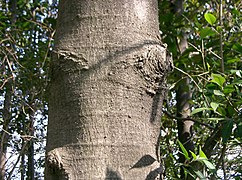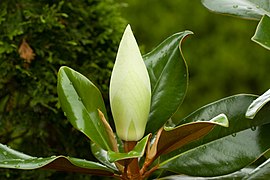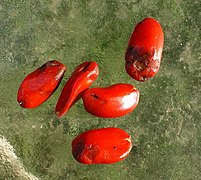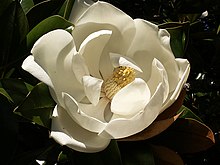Magnolia grandiflora
Magnolia grandiflora, commonly known as magnolia grandiflora, common magnolia or simply magnolia , is an arboreal species belonging to the Magnoliaceae family, native to the southeastern United States. It is very common to see it cultivated as an ornamental plant.
Description
It is an evergreen tree that can reach more than 30 m in height. It forms a dense, slightly pyramidal crown. Gray or light brown trunk with smooth bark when young, becoming ridged with age. The alternate leaves are simple, elliptic to oblong-ovate or broadly ovate, and margin entire. They measure 10-20 cm in length by 7-10 cm in width, with entire margins, of a dark shiny green color and coriaceous texture, with a glabrous upper surface and somewhat pubescent underside; petiole with a short wooliness, like reddish or white velvety, like the buds and young branches. The fragrant flowers are hermaphroditic, solitary, 15 to 30 cm in diameter with 3 petaloid sepals and 6 petals —there can be up to 12— oval, with a waxen texture; with numerous stamens. The fruit is an aggregate of multiple berries (follicles) with 1 or 2 seeds in a reddish casing (aril) each, in the shape of an elongated pineapple with a woody texture.
Distribution and habitat
Native to the southeastern United States, from Virginia to Texas and Florida.
It inhabits humid wooded areas, near rivers and coastlines at low altitudes.
Ecology
Magnolia grandiflora can produce seeds at 10 years of age, although maximum seed production is reached around 25 years of age. About 50% of the seeds can germinate and are transmitted by birds and mammals. Squirrels, opossums, quail, and turkey have been known to eat the seeds.
Uses
It is commonly used in gardens as an ornamental tree due to the elegance of its appearance and the perfume of its enormous flowers.
Wood is valued in cabinetmaking for its quality, although as a slow-growing species, it is not economically profitable.
As a medicinal plant, the seeds and bark have been used since ancient times to alleviate digestive and respiratory ailments. In Mexico, the flowers are also used in infusion for heart conditions.
The flower also has various uses in perfumery.
Phytochemistry
The plant contains phenolic components with antimicrobial properties. In pharmacological studies, magnolol honokiol and 3,5'-dialyl-2'-hydroxy-4-methoxybiphenyl have shown great effectiveness against Gram-positive and acid-fast bacteria and fungi. An essential oil has been isolated from the leaves and bark, the alkaloids aztequina, thalaumin and tyramine, beta-sitosterol, and costunolide.
Taxonomy
Magnolia grandiflora was described by Carlos Linnaeus and published in Systema Naturae, Editio Decima 2: 1082. 1759.
Etymology
Magnolia: generic name given in honor of Pierre Magnol, a botanist from Montpellier (France).
grandiflora: Latin epithet meaning "large flowers".
- Morphology
Synonymy
- Magnolia longifolia Sweet, Hort. Brit.: 11 (1826).
- Magnolia elliptic (W.T.Aiton) Link, Handbuch 2: 375 (1829).
- Magnolia lanceolata (Aiton) Link, Handbuch 2: 375 (1829).
- Magnolia obovata (W.T.Aiton) Link, Handbuch 2: 375 (1829), nom. illeg.
- Magnolia maxima Lodd. ex G.Don in J.C.Loudon, Hort. Brit.: 226 (1830).
- Magnolia lacunosa Raf, Autik. Bot.: 78 (1840).
- Magnolia microphylla Be., Fl. Jard. 3: 226 (1849), nom. inval.
- Magnolia obtusifoliaFl. Jard. 3: 226 (1849), nom. inval.
- Magnolia tardiflora Be., Fl. Jard. 3: 226 (1849), nom. inval.
- Magnolia tomentosa Be., Fl. Jard. 3: 226 (1849), nom. inval.
- Magnolia ferruginea W.Watson, Bull. Misc. Inform. Kew 1889: 305 (1889).
- Magnolia foetida (L.) Sarg., Gard. " Forest 2: 615 (1889).
- Magnolia hartwegii G.Nicholson, Hand-List of Trees and Shrubs 1: 17 (1894), nom. inval.
- Magnolia hartwicus G.Nicholson, Hand-List of Trees and Shrubs 1: 17 (1894), nom. inval.
- Magnolia stricta G.Nicholson, Hand-List of Trees and Shrubs 1: 17 (1894), nom. inval.
- Magnolia glabra P.Parm, Bull. Sc. France Belgique 27: 251 (1896).
- Magnolia angustifolia Millais, Magnolias: 55, 83 (1927).
- Magnolia exoniensis Millais, Magnolias: 59 (1927).
- Magnolia galissoniensis Millais, Magnolias: 60 (1927).
- Glorious magnolia Millais, Magnolias: 61 (1927).
- Magnolia praecox Millais, Magnolias: 69 (1927).
- Magnolia pravertiana Millais, Magnolias: 69 (1927).
- Magnolia rotundifolia Millais, Magnolias: 70 (1927).
History
In the XVI century, Francisco Hernández de Toledo mentions that
This plant is of a hot and dry nature, strengthens the heart, stomach, and significantly damages the loose belly. Cooking mixed with other plants and infused in the uterus is an excellent remedy of sterility.
At the end of the XVIII century, Vicente Cervantes points out: the leaves are astringent and corroborating, their cooking is use for gout.
In the XIX century, Eleuterio González cites: the infusion of the flowers is antispasmodic, and the tincture tonic. They have been used in epilepsy and neurosis in general.
Contenido relacionado
Joshua lederberg
Common salt
European Organization for Space Research







